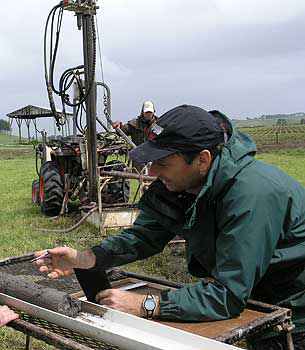Funding awarded for Taranaki eruption recovery plan

Lessons from the Christchurch rebuild will be included in an economic model to aid the recovery from any future volcanic eruption in Taranaki.
The project, led by the Volcanic Risk Solutions team at Massey University and Market Economics Ltd, will draw upon a decade of research and provide the tools for government and other stakeholders to achieve swift recovery from an eruption.
The team has been awarded $250,000 for the project by the Ministry of Science and Innovation’s New Zealand Natural Hazards Research Platform. Volcanologists and statisticians from Massey will work with a Market Economics team of environmental and ecological economists led by Massey graduate Dr Garry McDonald.
Massey University Professor Shane Cronin says the model will start with realistic volcanic eruption scenarios tailored to Mt Taranaki.
“An economic recovery model is being developed and tested through the Christchurch earthquake, where you have a long-term impact on a large complex community,” he says. “We can use that same framework to forecast what it will cost and what impact there might be if Taranaki erupts. This will show clearly the pathway to most effective steps needed to hasten a rebuilding of the region’s economy.”
However, Professor Cronin says there are key differences between earthquakes and volcanic events that need to be taken into account.
“An earthquake stops when the shaking finishes, and then the problems begin in terms of what you do about rebuilding and dealing with liquefaction and destroyed lifelines. With a volcano, you can easily have eruption scenarios that last for many years or even decades, so we have to create a model that takes this variance into account.
“We will cover everything from infrastructure issues to business viability. The dynamic model will provide answers for government and businesses to help plan for any given situation.”
The project will be backed by a decade of research on Mt Taranaki carried out by Professor Cronin’s team. Already, a 10,000-year eruption history of the volcano has been published, and now a longer 32,000-year history is being completed thanks to a new core sample taken from a swamp near Eltham.
“It is one of the most detailed records of eruptions from a volcano over that length of time anywhere in the world,” Professor Cronin says.
This attention to detail has paid off, with the research showing that Taranaki has regular cycles of behaviour. “It oscillates between periods of smaller, but more frequent eruptions and larger, but less frequent ones,” he says. “The cycles last about 1,500 years. The mountain is in one of the quiet cycles at the moment, with the last eruption forming the summit dome around 1800AD.”
Professor Cronin says not only are they studying the frequency of volcanic events, but the nature of them as well.
“We have a long and full history, and understand that through statistics. But we also know about the physical and chemical magma processes at work when an eruption occurs. We have PhD student Rebecca Green working on improving statistical forecasts of eruptions via incorporating geochemistry and another student will soon start on defining the conditions responsible for the largest eruptions of Mt Taranaki.
“The aim is to extend our knowledge of the eruption cycle to know what drives it and to be sure of just where in that cycle we are,” he says. “Then we can more accurately forecast future volcanic activity. Of course, we not only want to know how often the volcano erupts, but how large those eruptions are, how long they might last, and whether they start with a bang or a whimper.”
Work is also being carried out on Mt Merapi in Indonesia, which is known as Taranaki’s sister volcano due to its similar size, shape and composition. “We’re trying to find out whether it has the same cycle. Is it a universal thing for these types of volcano or is it specific to Taranaki?”
Professor Cronin says Mt Taranaki has been the team’s passport into an understanding of volcanic systems that has gained interest globally, with several scientific papers on the volcano published in top international journals such as Geology.
“We began our latest phase of work here in 2002 and so far we’ve had four PhD students and two Master’s students complete their research on the mountain, along with the two PhD students currently working there.”